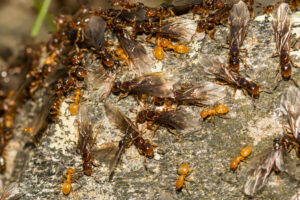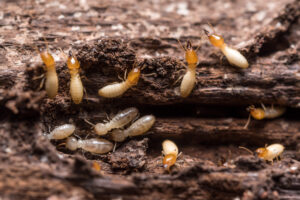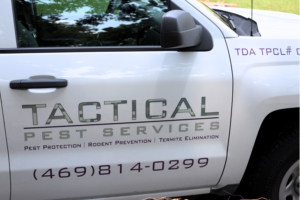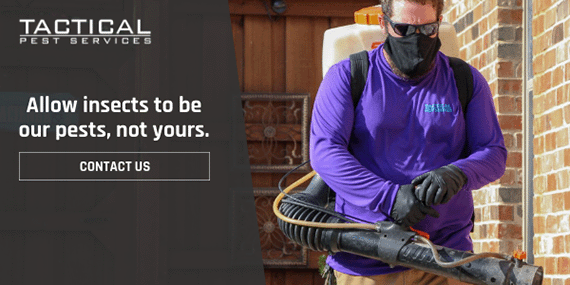When it comes to pests in your home, ants and termites are two of the most commonly misidentified insects. They may look a bit alike, but don’t be fooled—they each have their shenanigans and can cause quite the ruckus in your home. Let’s first dive into the key features of each pest, their behaviors, and then their differences.
Ant Swarmers Unique Characteristics

Ant swarmers are driven by environmental factors like temperature and humidity. They are reproductive members of an ant colony and their main purpose is to establish new colonies. Swarmers participate in nuptial flights, which is a mating event where these insects leave their nests in large numbers. The females land and start new colonies while males typically die afterwards. The queen will get to work laying eggs for her new colony and establish a new nesting site, normally located outside, but they enter homes in search of food or when it is too hot or cold outside.
The main features to pay attention to in ant swarmers are:
- Three-part body structure: the head, thorax, and abdomen.
- Membranous wings that can be translucent or slightly tinted.
- Swarmers exhibit a variety of colors, including black, brown, and yellowish tones.
- They can range from a few millimeters to over an inch long, varying between species.
Ant swarmers also exhibit a highly organized social structure, and each ant has distinct roles that contribute to the colony’s success. The queen’s main function is reproduction, and depending on the species she may lay thousands of eggs. For the colony’s survival, worker ants have designated tasks including foraging for food, caring for the queen’s offspring, maintaining the nest, and lastly defending the colony.
If you have spotted one ant in your home, then it likely means colonization has already started. Contact Tactical, a professional pest control service for ants so we can tackle your pest problem early on.
The Dangers Of Termites And Their Habits

Termites are known to cause significant damage to wooden structures and are often referred to as “silent destroyers” due to their extensive harm without being noticed. Termites also live in large colonies with designated caste systems. Like flying ants, termites leave their colonies to engage in mating flights during specific times of the year. These colonies can range from 60,000 to 1 million depending on the species, and they can be found in decaying trees, stumps, lumber, and wooden members of structures. They also tend to remain hidden, often working in dark environments, further complicating early detection.
The main features to look for in termites include:
- A smooth, cylindrical body.
- Straight antennae are composed of small, bead-like segments.
- They have two sets of wings, and each set of wings is equal in shape and size.
- Termites range in size from ⅛ inch to 1 inch in length.
Termites are also social insects that have an organized structure in their colony. Each caste has its own specialized function which includes the king, queen, soldiers, and worker termites. They communicate through vibrations and pheromones, and this supports their structure by recognizing nest mates by scent. Termites are experts at breaking down cellulose since they have microorganisms, including bacteria and protozoa, that inhabit their guts. This allows termites to thrive on a diet primarily composed of wood and other plant materials. However, when they decide to munch on the wooden beams of your home, their talent can turn into a nightmare.
It is critical to prevent termite damage in your home or you can face costly repairs. At Tactical, we offer a free termite service inspection. We can recommend a treatment plan to fit your home and budget needs. Call today to learn more about our termite services.
Ant Swarmers Vs. Termites Traits:
Termites are not dangerous themselves, as they do not bite, sting, or transmit diseases, but they are very dangerous to one’s property as they go undetectable for a long time. While flying ants are also not considered dangerous, they can bite, and some species can also sting, but they are not typically aggressive towards humans. Ant swarmers and termites have distinct features and roles that set them apart. Here’s a deeper look at their differences to help you identify which insect you’re encountering:
Ant swarmers vs termites physical traits comparison:
- Narrow waist vs cylindrical body shape
- Elbowed antennae vs straight, beaded antennae
- Larger front wings than hind wings vs equally-sized front and hind wings
Ecological Roles
Ants and termites have specific ecological roles. Ants contribute to soil aeration and nutrient cycling by their tunneling behavior. They can help control pest populations by acting as predators and can also engage in seed dispersal, promoting plant diversity. On the other hand, termites are decomposers that help enrich the soil and foster healthy vegetation by breaking down cellulose from woods and plants.
Swarming Behaviors
Another key difference is their swarming behaviors. Ant swarming occurs in late spring or early summer when winged males and females leave the nest and mate before the females land and seek new nesting sites. In contrast, termite swarming usually takes place in humid conditions and can last several days. Termites also tend to remain closer to their original nests as they search for new colony locations.
Diet Preferences
Ants are omnivorous and feed on other insects, seeds, nectar, and various other substances. This diverse diet allows them to thrive in various environments and engage in beneficial relationships with plants and other insects. In comparison, termites primarily consume wood and other cellulose-based products since they are remarkable at breaking down cellulose.
How to Handle an Infestation

Dealing with an infestation of ant swarmers or termites can be stressful, but knowing how to handle the situation can make all the difference! Firstly, identify the insect, and look for key characteristics like their body shape, wing size, and color. Then, Contact Tactical Pest Services! If you notice any issues, we can provide a thorough inspection, identification, and the extent of the infestation. Learn how we can assist you quickly at an affordable cost!


